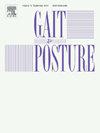健康老年人无标记三维步态生物力学构建效度
IF 2.2
3区 医学
Q3 NEUROSCIENCES
引用次数: 0
摘要
背景和目的随着年龄的增长,老年人的关节角度和力矩会发生变化,步态变化会导致功能受限和更高的跌倒风险。基于标记的步态分析因其复杂性和不适感,并未广泛应用于临床,尤其是老年人。Theia3D 等无标记运动捕捉技术的最新进展为我们提供了一个前景广阔的替代方案。本研究旨在评估用于健康老年人步态分析的无标记运动捕捉系统的结构有效性。研究人员分别穿着贴有 46 个反光标记的紧身极简服装或平时穿着的服装,使用有标记和无标记运动捕捉系统以随机顺序收集步态数据。对关节运动学(包括运动范围)和动力学进行了分析,并评估了不同方法之间的相关性(Rxy)。Bland&Altman 分析用于测量一致性。计算均方根差异(RMSD)。运动学的可接受阈值设定为≤5º,动力学的可接受阈值设定为≤信号振幅的 10%。结果在矢状面运动学方面(骨盆除外),特别是膝关节和踝关节方面,各系统之间发现了很强的相关性(Rxy≥0.7)。矢状面髋关节和骨盆运动学的一致性较低,RMSD 超过 5º。横向和正面运动的相关性较弱,一致性较差。结论总体而言,无标记运动捕捉在测量健康老年人矢状面步态下肢步态运动学(不包括骨盆)和运动学方面表现出良好的构造效度。然而,考虑到不同方法之间的一致性以及其他运动平面的结果,在步态评估中交替使用无标记系统和基于标记系统之前,还需要进一步的验证。本文章由计算机程序翻译,如有差异,请以英文原文为准。
Construct validity of markerless three-dimensional gait biomechanics in healthy older adults
Background and aim
Gait changes due to aging can result in functional limitations and a higher risk of falls, with older adults showing alterations in joint angles and moments. Marker-based gait analysis is not widely used in clinical settings due to its complexity and discomfort, especially in older adults. Recent advances in markerless motion capture, such as Theia3D, offer a promising alternative. This study aims to assess the construct validity of a markerless motion capture system for gait analysis in healthy older adults.
Methods
A cross-sectional study included 30 healthy community-dwelling older adults. Gait data was collected using marker-based and markerless motion capture systems in randomized order, with participants wearing tight-fitting minimal clothes plus 46 reflective markers attached, or their usual clothes, respectively. Joint kinematics (including range of motion) and kinetics were analyzed, and correlations between methods (Rxy) were assessed. Bland&Altman analysis was used to measure agreement. Root-mean-square differences (RMSD) were computed. Acceptable thresholds were set at ≤ 5º for kinematic and at ≤ 10 % of signal amplitude for kinetics.
Results
Strong correlations (Rxy≥0.7) were found between the systems for sagittal plane kinematics (except for the pelvis), particularly for knee and ankle joints. A low agreement was detected in sagittal plane hip and pelvis kinematics, along with RMSD exceeding 5º. Weaker correlations and poor agreement were observed for transverse and frontal plane motions. Overall strong correlations were found for kinetics, except for the joint ankle inversion-eversion moment, and poor agreement for the frontal and transverse planes.
Conclusion
Overall markerless motion capture demonstrated good construct validity for measuring sagittal plane gait lower-limb gait kinematics (excluding pelvis) and kinetics in healthy older. However, considering the agreement between methods and the results for the other movement planes, further validation is required before markerless and marker-based systems can be used interchangeably in gait assessments.
求助全文
通过发布文献求助,成功后即可免费获取论文全文。
去求助
来源期刊

Gait & posture
医学-神经科学
CiteScore
4.70
自引率
12.50%
发文量
616
审稿时长
6 months
期刊介绍:
Gait & Posture is a vehicle for the publication of up-to-date basic and clinical research on all aspects of locomotion and balance.
The topics covered include: Techniques for the measurement of gait and posture, and the standardization of results presentation; Studies of normal and pathological gait; Treatment of gait and postural abnormalities; Biomechanical and theoretical approaches to gait and posture; Mathematical models of joint and muscle mechanics; Neurological and musculoskeletal function in gait and posture; The evolution of upright posture and bipedal locomotion; Adaptations of carrying loads, walking on uneven surfaces, climbing stairs etc; spinal biomechanics only if they are directly related to gait and/or posture and are of general interest to our readers; The effect of aging and development on gait and posture; Psychological and cultural aspects of gait; Patient education.
 求助内容:
求助内容: 应助结果提醒方式:
应助结果提醒方式:


